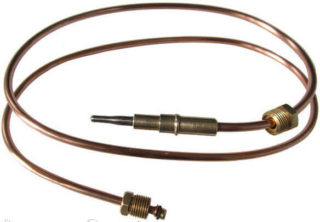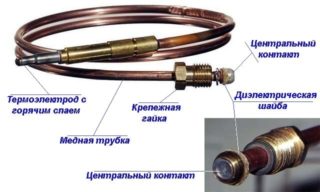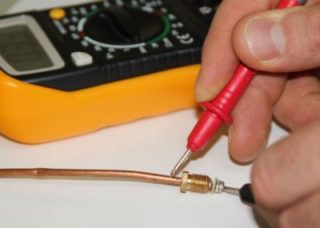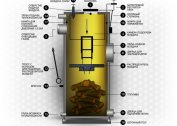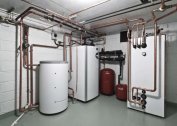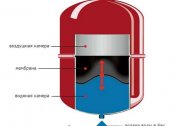All heating boilers should be equipped with devices to control the operation of the device, to protect it from overheating. A similar element is a thermocouple for a gas boiler. It has a fairly simple design, its action is based on individual laws of physics.
The device and principle of operation of a thermocouple
This mechanism ensures the safety of the heating equipment.
Device:
- It consists of 2 conductors of different types, contacting without fail in one or two places.
- When heated between different types of conductors, a voltage is created, which is subsequently used in the operation of the heating unit.
- Due to the properties of the conductors, there is no need to use the external excitation of the heating device, the elements are powered offline.
A thermocouple is a temperature indicator sensor in a heating unit. Its device is quite simple, but when buying, you should definitely check the quality of the connection points. Otherwise, an unacceptable error may occur in excess of 1 ° C.
Operating principle:
- The connection points of dissimilar metals are heated to a certain temperature value.
- A measuring device is connected to the cold ends of the conductors on which the voltage is generated, the circuit closes.
- Induction occurs in the valve coil, under the influence of which it opens and lingers in such an arrangement.
If the gas heating unit is out of order, it is recommended first to check if the thermocouple is working. It most often causes a malfunction of the entire system.
Control sensors are made of base metals. In order to reliably protect themselves from external influences, they are placed in a pipe, the movable flange present fixes the structure. The latter consists of the following elements:
- tight case with a cover;
- porcelain speakers (fastened to the head with screws).
Material for production is determined by the range of temperatures that will be measured by the device.
Main types
The following types of appliances installed in gas heating boilers are considered the most popular.
Type K
It is the most common. Marking - THA. The composition contains plates of chromel, aluminum. Operating temperature range - from -200 to + 1350 ° С. Devices are very sensitive to any temperature changes, but are highly dependent on the external environment.
Type E
It is made from chromel and constant. It has high reliability. Marking of the manufacturer - THKn. Operating temperature range - 0 - 600 ° С.
Type N
It is a modification of type E, capable of operating at temperatures up to +1200 ° C. For the production of plates, nichrosil and nisil are used. Such models are considered the most accurate devices used in heating equipment.
Advantages and disadvantages
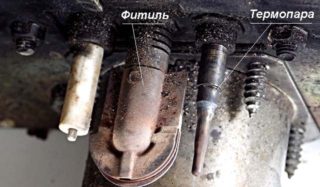
Thermocouple has many advantages:
- Low price due to the lack of expensive parts and materials.
- Long term use.
- Easy installation and replacement.
- A huge range of measured temperatures.
- Accuracy.
Some cons:
- Disproportionate increase in temperature and potential difference (there is no linear relationship).
- The boundary voltage limit is 50 mV.
If the thermoelectric sensor fails due to poor-quality junction, it cannot be repaired.
Sometimes the thermocouple stops functioning due to poor contact at the connection point. To fix such a problem, you need to unscrew the nut, remove the conductor, clean its end, assemble everything back.
Thermocouple in gas control system
Any thermocouples for a gas boiler have the same principles of operation:
- The user mechanically opens the valve for gas supply by pressing a button for 15-30 s.
- After switching on the piezo ignition, a spark appears, the burner ignites.
- The solenoid valve button is held for another 30-60 s until the thermocouple junction produces the required voltage.
- Following the cancellation of the effect on the button, the combustion does not stop, since the heated thermocouple creates the necessary voltage to keep the valve open. The heating unit is operating normally.
- When there is no combustion, the flame does not heat the sensor, resulting in insufficient voltage to keep the valve open. Therefore, it closes, the gas supply stops.
Most models of control sensors are suitable for a wide variety of gas heating units. This is due to the simplicity of their device, versatility.
Installing a thermocouple on a gas boiler
Connection is carried out only with wires made of thermocouple material or metal with similar parameters. On the eve of connecting the thermocouple, you need to strip the ends of the wires to improve the accuracy of measurements. During installation, make sure that all gas pipes are pointing down.
When a breakdown occurs, the device cannot be set up. Therefore, you need to understand how to check the thermocouple with a multimeter.
To study the operability of the device, it is necessary to connect one end to the multimeter, and the other to be heated with a lighter. A working thermocouple has an approximate voltage of 50 mV.
DIY repair
For troubleshooting, you need:
- Using a wrench, unscrew the clamping nut, remove the elements.
- Clean the ends of dirt.
- Check the thermocouple with a multimeter.
- Compare the required values of indicators.
- Assemble a thermocouple, turn on the boiler.
Temperature control sensors are actively used in modern automation of gas boilers. If the consumer needs an explanation to select the right device, it is recommended to consult a specialist. He will tell you which model to choose so that it matches the parameters of the gas unit.
Thermocouple is the only accurate sensor designed to measure high temperatures. It is widely used in boiler equipment to control and protect against overheating.
